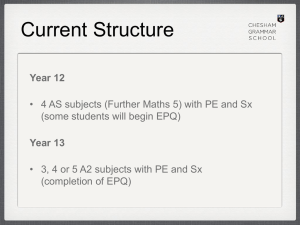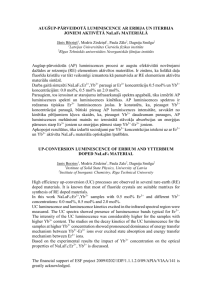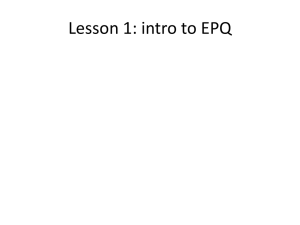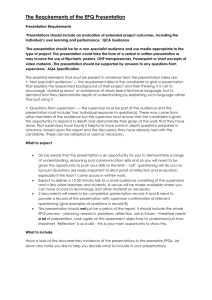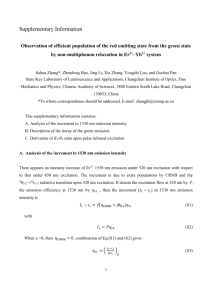Spectra and 1 - AIP FTP Server
advertisement
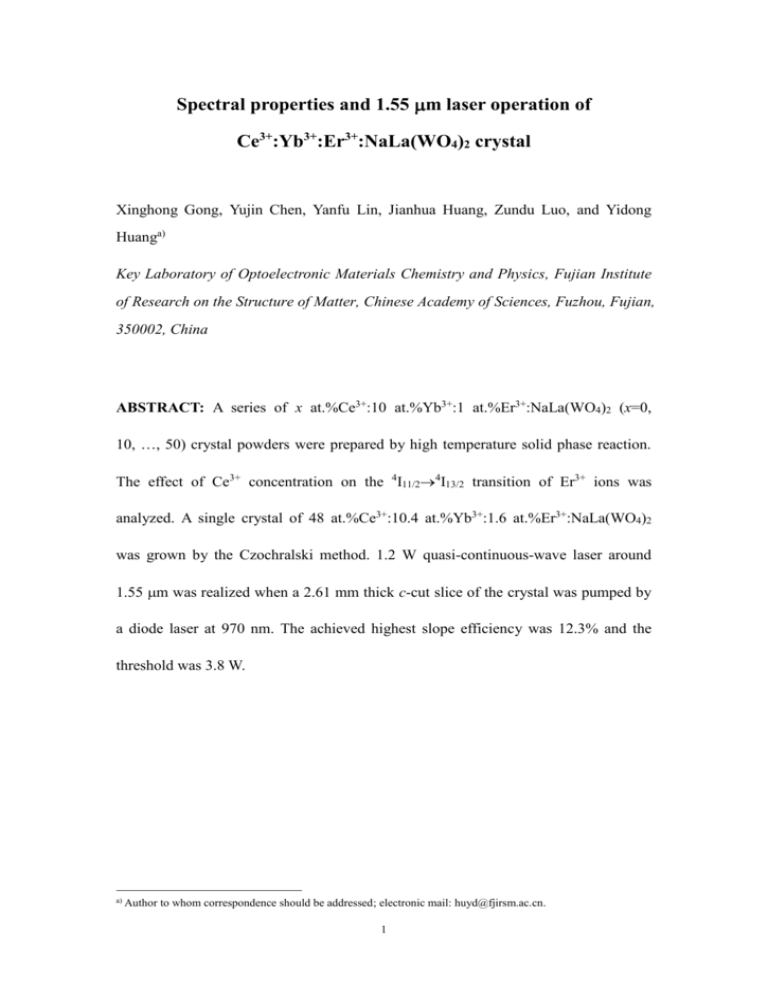
Spectral properties and 1.55 m laser operation of Ce3+:Yb3+:Er3+:NaLa(WO4)2 crystal Xinghong Gong, Yujin Chen, Yanfu Lin, Jianhua Huang, Zundu Luo, and Yidong Huanga) Key Laboratory of Optoelectronic Materials Chemistry and Physics, Fujian Institute of Research on the Structure of Matter, Chinese Academy of Sciences, Fuzhou, Fujian, 350002, China ABSTRACT: A series of x at.%Ce3+:10 at.%Yb3+:1 at.%Er3+:NaLa(WO4)2 (x=0, 10, …, 50) crystal powders were prepared by high temperature solid phase reaction. The effect of Ce3+ concentration on the 4I11/24I13/2 transition of Er3+ ions was analyzed. A single crystal of 48 at.%Ce3+:10.4 at.%Yb3+:1.6 at.%Er3+:NaLa(WO4)2 was grown by the Czochralski method. 1.2 W quasi-continuous-wave laser around 1.55 m was realized when a 2.61 mm thick c-cut slice of the crystal was pumped by a diode laser at 970 nm. The achieved highest slope efficiency was 12.3% and the threshold was 3.8 W. a) Author to whom correspondence should be addressed; electronic mail: huyd@fjirsm.ac.cn. 1 I. INTRODUCTION Er3+ is a well-known active ion for solid-state laser in the infrared and visible ranges due to its intricate energy level structure. In recent years, much attention has been devoted to the research of Er3+-doped laser material mainly because its emission around wavelength of 1.55 m via the transition of 4I13/24I15/2 is eye-safe and matches the so-called third telecommunication window very well1-5. Generally, Yb3+ ions with large absorption cross-section around 970 nm, i.e. the emission wavelength of InGaAs diode laser, are generally co-doped as sensitizer to improve the performance of Er3+ laser owing to the resonant energy transfer from Yb3+ (2F5/2) to Er3+ (4I11/2)5-10. However, for hosts with low phonon energy, efficient 1.55 m laser can’t be realized due to the up-conversion and back energy transfer caused by the long fluorescence lifetime of the 4I11/2 multiplet11-13. Since the energy interval between the 4 F7/2 and 4F5/2 multiplets of Ce3+ ions is close to that between the 4I11/2 and 4I13/2 of Er3+, the Ce3+ ions can be used as the deactivator to shorten the fluorescence lifetime of the 4I11/2 multiplet and then improve the laser performance14-21. NaLa(WO4)2 crystal belongs to the tetragonal system with space group I41/a, and the cell constants are a=5.349 Å, c=6.936 Å, Z=2, and d=6.56 g/cm3 22 . The crystal melts congruently at 1140 °C and can be grown by the Czochralski method23. Both Nd3+ and Yb3+ ions singly doped NaLa(WO4)2 crystals have been demonstrated as excellent gain media for solid-state lasers24-27. However, as many tungstate host materials, efficient 1.55 m laser is obstructed by the long fluorescence lifetime of the 4 I11/2 multiplet of Er3+ ions due to the low phonon energy of [WO4]2- 11,28. 2 In this work, a series of x at.% Ce3+:10 at.%Yb3+:1 at.%Er3+:NaLa(WO4)2 (x=0, 10, …, 50) crystal powders are prepared by high temperature solid phase reaction and the effect of Ce3+ concentration on the transition of 4I11/24I13/2 is analyzed. A Ce3+, Yb3+ and Er3+ co-doped NaLa(WO4)2 crystal is grown by the Czochralski method. The polarization spectra of the Ce3+:Yb3+:Er3+:NaLa(WO4)2 crystal are analyzed and the laser operation around 1.55 m of the crystal is realized. II. EXPERIMENTAL PROCEDURE A series of crystal powders of x at.%Ce3+:10 at.%Yb3+:1 at.%Er3+: NaLa(WO4)2 with the concentration of Ce3+ ions changing from 0 at.% to 50 at.% with interval of 10 at.% were prepared by high temperature solid phase reaction. The powders were identified by the X-ray powder diffraction method. A 48 at.%Ce3+:10.4 at.%Yb3+:1.6 at.%Er3+:NaLa(WO4)2 single crystal was grown by the Czochralski method and the segregation coefficient of Ce3+, Yb3+, and Er3+ ions in NaLa(WO4)2 crystal is estimated to be 1.2, 0.52, and 0.8, respectively. The crystal as grown is yellow, which may be caused by the color centers formed with high doping of Ce3+. The single crystal was oriented by means of the X-ray diffraction and polarized microscopy. For the spectral experiment, a slice with dimensions of 431 mm3 was cut from the single crystal with the polished face of 43 mm2 parallel to the c axis of the uniaxial crystal. The absorption spectra of the crystal slice in a range of 400-1700 nm were recorded using a Perkin-Elmer UV-VIS-NIR spectrometer (Lambda–900). The 3 fluorescence spectra of the powder and crystal samples in a range from 1400 to 1700 nm were recorded using a spectrophotometer (FL920, Edinburgh) when the samples were excited at 975 nm by a Xe-lamp. The fluorescence signals were detected with an NIR PMT (R5509, Hamamatsu). Fluorescence decay curves of powder samples at 1010 nm corresponding to the transition from the 2F5/2 multiplet of Yb3+ ions and both powder and crystal samples at 1535 nm corresponding to the transition from the 4I13/2 multiplet of Er3+ ions were recorded by the same spectrophotometer when the samples were excited at 975 nm by a microsecond flash lamp (F900, Edinburgh). Furthermore, the up-conversion fluorescence signals of powder samples past a monochromator (Triax550, Jobin-Yvon) were detected with a PMT (R928, Hamamasu) when the samples were excited at 975 nm by a Xe-lamp. The above fluorescence spectra of powder samples were recorded in the same experimental condition for comparison between different samples. All the spectral experiments were carried out at room temperature (RT). For the laser experiment, an end-pumped linear hemispherical resonator was adopted. The gain medium was a 2.61 mm thick c-cut crystal slice. The uncoated crystal slice was held in an aluminum mount and no special care was taken to ensure the cooling of the slice. In order to reduce the thermal load in the slice, a 970nm diode laser in pulse mode coupled by a fiber with 800 m diameter core (FAP-980, Coherent) was used as the pump source. The pulse duration was 2 ms and the duty cycle was 2%. The pump laser was focused into the gain medium with a waist diameter of about 290 m. The flat input mirror had 90% transmission at 970nm and 4 99.8% reflectivity at 1.5-1.6 m. Four output couplers with a same 50 mm radius of curvature and different transmissions of 1.0%, 1.8%, 3.8%, and 5.8% at 1.5-1.6 m were used. In order to reduce the cavity loss, the length of the hemispherical cavity was close to 50 mm. Output laser spectra were recorded by a monochromator (Triax550, Jobin-Yvon) with a thermoelectrically cooled Ge detector (DSS-G025T, Jobin-Yvon). III. RESULTS AND DISCUSSION A. Spectral properties of x at.%Ce3+:10 at.%Yb3+:1 at.%Er3+:NaLa(WO4)2 (x=0, 10, …, 50) crystal powders For the Yb3+, Er3+, and Ce3+ co-doping powders, several energy transfer processes would occur when the Yb3+ ions are excited to the 2F5/2 multiplet by 975 nm pump light. The main energy transfer routes between these ions are shown in Fig. 1. Firstly, the 4I11/2 multiplet of Er3+ ions will be populated mainly through the resonant energy transfer from the 2 F5/2 multiplet of Yb3+ ions (2F5/2(Yb3+)+4I15/2(Er3+)2F7/2(Yb3+)+4I11/2(Er3+)). Then, the upper level 4I13/2 of Er3+ ions for the 1.55 m laser is populated mainly through the relaxation from the 4I11/2 multiplet. With co-doping of Ce3+, the energy transfer from Er3+ to Ce3+ (4I11/2(Er3+)+2F7/2(Ce3+)4I13/2 (Er3+)+2F5/2(Ce3+)) will enhance the relaxation of 4 I11/24I13/2. Due to the low phonon energy of [WO4]2-, strong up-conversion originating from the 4I11/2 multiplet of Er3+ ions as shown in Fig. 1 has been observed in many 5 tungstates29~31. Fig. 2 shows the up-conversion fluorescence spectra of the 4S3/24I15/2 transition of Er3+ ions when the exciting wavelength is 975 nm. The strong up-conversion for the sample without doped by Ce3+ ions may originate from the excited-state absorption (ESA) of the 4I11/2(Er3+) multiplet and the consecutive energy transfer Yb3+(2F5/2)+Er3+(4I11/2)Yb3+(2F7/2)+Er3+(4F7/2). It can also be found from the figure that the up-conversion fluorescence of Er3+ ions decreases sharply with the increase of the Ce3+ concentration, and the up-conversion fluorescence is hardly detectable for the samples with concentration of Ce3+ higher than 30%. The energy transfer from Er3+ to Ce3+ not only weakens the up-conversion from the 4I11/2(Er3+) multiplet, but also improves the energy transfer efficiency of 2 F5/2(Yb3+)+4I15/2(Er3+)2F7/2(Yb3+)+4I11/2(Er3+). The efficiency can be estimated by 1 Yb:Er / Yb 20,32, where Yb:Er and Yb are the fluorescence lifetimes of the 2 F5/2 multiplet of Yb3+ ions in the samples co-doped with Er3+ ions and not, respectively, and which can be obtained by fitting the measured single exponential fluorescence decay curves of the 2F5/2 multiplet. As shown in Fig. 3, the energy transfer efficiency is improved from 34% to 85% with the increment of the Ce3+ concentration from 0 to 40 at.%. The results can be confirmed by the enhanced fluorescence around 1.55 m as shown in Fig. 4 when the samples are excited at 975 nm. The single exponential fluorescence decay curves at 1535 nm corresponding to the transition from the 4I13/2 multiplet of Er3+ ions were also measured when the samples were excited at 975 nm. The fitted fluorescence lifetimes of the 4I13/2 6 multiplet for all the samples as a function of Ce3+ concentration are shown in Fig. 5. The lifetime is shortened from 4.1 to 2.9 ms for the sample with x=0 to x=50, which may be caused mainly by the increase of crystal defects with the Ce3+ concentration. B. Spectral properties of Ce3+:Yb3+:Er3+:NaLa(WO4)2 single crystal The RT polarized absorption spectra of the 48 at.%Ce3+:10.4 at.%Yb3+:1.6 at.%Er3+:NaLa(WO4)2 single crystal are shown in Fig. 6. The absorption spectra related to the Er3+ ions were analyzed by the Judd-Ofelt (J-O) theory32,33. The detailed calculation procedure is similar to that reported in Ref. 34. The values of the refractive indices for and polarizations were taken from Ref. 26 and the reduced matrix elements of unit tensor operators used in the calculation could be found in Ref. 35. The measured and calculated oscillator strength, denoted as fexp and fcal, respectively, and the root mean square deviations RMS f are listed in Table I. For the Er3+ ions, the magnetic dipole transition of 4I15/24I13/2 cannot be ignored35 and the values of fmd are also listed in Table I. The calculated intensity parameters Ωtq and the effective intensity parameters are listed in Table II. The effective intensity parameters were calculated from teff (2 t t ) / 3 36. The intensity parameters of some other Er3+-doped crystals reported are also listed in Table 2 for comparison. On the basis of the calculated intensity parameters, the values of spontaneous emission probability AJJ’, fluorescence branching ratio , and radiative lifetime r for the main fluorescence levels of Er3+ ions in the crystal could be calculated and the results are listed in Table III. 7 For the important 4I13/24I15/2 transition of Er3+ ions, the emission cross section at wavelength can be obtained from the measured fluorescence spectra by the Fuchtbauer-Landenburg (F-L) formula42 or from the absorption spectra by the reciprocity method43. Fig. 7 shows the polarized emission cross section spectra obtained by these two methods. Here, the Stark level data of Er3+ ions in NaGd(WO4)2 crystal34 were adopted in the reciprocity method since both the NaLa(WO4)2 and NaGd(WO4)2 crystals are similar in structure and composition. It can be seen that, due to the re-absorption of the emission from the 4I13/24I15/2 transition44, the emission cross sections calculated by the F-L formula are smaller in the shorter wavelength region but larger in longer wavelength region compared with those calculated by reciprocity method. The peak emission cross sections calculated by the reciprocity method are about 0.8310-20cm2 (-polarized) and 0.7710-20cm2 (-polarized), which are comparable to those of some other Er3+-doped materials, such as 0.9510-20cm2 (-polarized) 0.8610-20cm2 and (-polarized) for Ce3+:Er3+:NaLa(MoO4)216, and 1.1310-20cm2 (-polarized) and 0.6410-20cm2 (-polarized) for Er3+:YAl3(BO3)445, but smaller than 1.8710-20 (E//Ng), 1.7910-20 (E//Np), and 2.8510-20 (E//Nm) for KLu(WO4)211. The fluorescence lifetime of the 4 I13/2 multiplet of the crystal was measured to be 3.6 ms, which is longer than the radiative lifetime calculated by the J-O method. This discrepancy, on the one hand, may originate from the uncertainty of the J-O calculation; on the other hand, may be caused by the re-absorption effect. Considering the long fluorescence lifetime of the 4 I13/2 multiplet in the crystal and the high fluorescence quantum efficiency of the 8 multiplet in the tungstates29,34, a low threshold laser around 1.55 m can be expected in the Ce3+:Yb3+:Er3+:NaLa(WO4)2 crystal. Since the Er3+ laser around 1.55 m via the 4I13/24I15/2 transition operates in three-level scheme, the possible laser wavelength can be estimated by the gain cross section46 q q Gq ( ) P em ( ) (1 P) abs ( ) where P is the population inversion ratio of Er3+ ions. The wavelength dependences of polarized gain cross section for different P values (P=0.3, 0.4, …, 0.7) are shown in Fig. 8. The smooth and broad gain curves indicate that the Ce3+:Yb3+:Er3+:NaLa(WO4)2 is a good candidate for gain medium of tunable and ultra-short lasers. IV. QUASI-CW LASER PERFORMANCE AROUND 1.55 μm In the laser experiment, as expected, only weak upconversion green fluorescence was observed and the laser oscillation around 1.55 m was realized. Fig. 9 shows the laser output power versus the absorbed pump power for the four output couplers. Because the duty cycle of the quasi-cw pulse laser was 2%, the values in the figure are the measured ones multiplied by 50. For the output coupler with 1.8% transmission, the achieved maximum output power is 1.2 W with slope efficiency of 12.3%, and the absorbed pump threshold power is 3.8 W. The output power and slope efficiency for the Er3+:Yb3+:Ce3+:NaLa(WO4)2 crystal are obviously higher than those of Er3+:Yb3+:KYW (80 mW and 1.6%) and Er3+:Yb3+:KLu(WO4)2 (152 mW and 1.2%) 9 crystals without Ce3+ ions11. Fig. 10 shows the output laser spectra for the four output couplers when the absorbed power is 13.6 W. It can be found that the laser wavelength shifts from 1590 to 1555 nm when the output-coupler transmission increases from 1.0% to 5.8%. The shift of the laser wavelength with the increment of output coupler transmission can be explained by the -polarized gain curves shown in Fig. 8.9 V. CONCLUSION Ce3+ ions as the deactivator have been introduced to Er3+:Yb3+:NaLa(WO4)2 crystal to enhance the 4I11/24I13/2 relaxation of Er3+ ions by the energy transfer 4 I11/2(Er3+)+2F7/2(Ce3+)4I13/2(Er3+)+2F5/2(Ce3+) and then improve the laser performance around 1.55 m via the 4I13/24I15/2 transition of Er3+ ions. The experiment results obtained from a series of x at.%Ce3+:10 at.%Yb3+:1 at.%Er3+:NaLa(WO4)2 (x=0, 10, …, 50) crystal powders indicate that the up-conversion fluorescence originating from the 4I11/2 multiplet of Er3+ ions is restrained significantly for the samples with concentration of Ce3+ higher than 30% and the energy transfer efficiency of Yb3+Er3+ is improved from 34% to 85% with the increment of the Ce3+ concentration from 0 to 40 at.%. However, the fluorescence lifetime of the 4I13/2 multiplet of Er3+ ions is shortened from 4.1 to 2.9 ms with the increment of the Ce3+ concentration from 0 to 50 at.%, which may be caused mainly by the increase of crystal defects with the Ce3+ concentration. A 48 at.%Ce3+:10.4 at.%Yb3+:1.6 at.%Er3+:NaLa(WO4)2 single crystal was obtained by the Czochralski 10 method. The spectral properties of the crystal were analyzed and the results show that the Ce3+:Yb3+:Er3+:NaLa(WO4)2 is a good candidate for 1.55 m laser. Quasi-continuous wave laser oscillation around 1.55 m was realized when this crystal was pumped by diode laser at 970 nm. The achieved highest output powder and slope efficiency were 1.2 W and 12.3%, respectively, and the threshold was 3.8 W. More efficient laser operation around 1.55 m may be expected when the concentrations of Yb3+ and Er3+ are also optimized and the quality of the crystal is further improved, and this work is in progress. ACKNOWLEDGMENTS This work has been supported by the National Natural Science Foundation of China (grants 50802094 and 50972142), the Major Programs of the Chinese Academy of Sciences (grant SZD08001-1), and the Chinese National Engineering Research Center for Optoelectronic Crystalline Materials. 11 REFERENCES 1 K. Kopczynski, Z. Mierczyk, and S. M. Kaczmarek, SPIE. 3186, 292 (1997). 2 W. J. Miniscalco and J. Lightwave Technol. 9, 234 (1991). 3 M. Arumugam and Pramana J. Phys. 57, 849 (2001). 4 Q. Wang, N. K. Dutta, and R. Ahrens, J. Appl. Phys. 95, 4025 (2004). 5 A. A. Kaminskii, V. S. Mironov, A. Kornienko, S. N. Bagaev, G. Boulon, A. Brenier, and B. D. Bartolo, Phys. Stat. Sol. A 151, 231 (1995). 6 Y. J. Chen, Y. F. Lin, X. H. Gong, Q. G. Tan, Z. D. Luo, and Y. D. Huang, Appl. Phys. Lett. 89, 241111 (2006). 7 T. Schweizer, T. Jensen, E. Heumann, and G. Huber, Opt. Commun. 118, 557 (1995). 8 N. A. Tolstik, A. E. Troshin, S. V. Kurilchik, V. E. Kisel, N. V. Kuleshov, V. N. Matrosov, T. A. Matrosova, and M.I. Kupchenko, Appl. Phys. B 86, 275 (2007) 9 S. Taccheo, P. Laporta, and C. Svelto, Appl. Phys. Lett. 68, 2621 (1996). 10 C. Li, R. Moncorge, J. C. Souriau, C. Borel, and C. Wyon, Opt. Commun. 107, 61 (1994). 11 S. Bjurshagen, P. Brynolfsson, V. Pasiskevicius, I. Parreu, M. C. Pujol, A. Pena, M. Aguilo, and F. Diaz, Appl. Opt. 47, 656 (2008). 12 I. Sokolska, E. Heumann, S. Kuck, and T. Lukasiewicz, Appl. Phys. B 71, 893 (2000). 13 A. M. Tkachuk, I. K. Razumova, A. A. Mirzaeva, A. V. Malyshev, and V. P. Gapontsev, J. Opt. Technol. 67,851 (2000). 12 14 E. Sani, A. Toncelli, and M. Tonelli, Opt. Mater. 28 1317 (2006). 15 J. Xu, L. B. Su, H. J. Li, D. Zhang, L. Wen, H. Lin, and G. J. Zhao, Opt. Mater. 29, 932 (2007). 16 E. Sani, A. Toncelli, M. Tonelli, D. A. Lis, E. V. Zharikov, K. A. Subbotin, and V. A. Smirnov, J. Appl. Phys. 97, 123531 (2005). 17 B. Simondi-Teisseire, B. Viana, A. Lejus, J. Benitez, D. Vivien, C. Borel, R. Templier, and C. Wyon, IEEE J. Quantum Electron. 32, 2004 (1996). 18 K. Nagamatsu, S. Nagaoka, M. Higashihata, N. J. Vasa, Z. Meng, S. Buddhudu, T. Okada, Y. Kubota, N. Nishimura, and T. Teshima, Opt. Mater. 27, 337 (2004). 19 C. Strohhofer, and A. Polman, Opt. Mater. 17, 445 (2001). 20 K. A. Subbotin, A. Lis, E. Sani, A. Toncelli, M. Tone11i, V. A. Smirnov, and E. V. Zharikov, Proc. SPIE. 6258,625805 (2006). 21 Y. G. Choi, D. S. Lim, K. H. Kim, D. H. Cho, and H. K. Lee, Electron. Lett. 35, 1765 (1999). 22 K. Byrappa and A. Jain, J. Mater. Res. 11, 2869 (1996). 23 Z. Cheng, Q. Lu, S. Zhang, J. Liu, X. Yi, F. Song, Y. Kong, J. Han, and H. Chen, J. Cryst. Growth. 222,797 (2001). 24 M. Rico, J. Liu, J. M. Cano-Torres, A. Garcia-Cortes, C. Cascales, C. Zaldo, U. Griebner, and V. Petrov, Appl. Phys. B 86, 621 (2005). 25 Y. P. Wei, C. Y. Tu, H. Y. Wang, F. G. Yang, G. H. Jia, Z. Y. You, X. A. Lu, J. F. Li, Z. J. Zhu, and Y. Wang, Opt. mater. 29, 1653 (2007). 26 J. Liu, M. Rico, U. Griebner, V. Petrov, J. M. Cano-Torres, F. Esteban-Betegon, 13 M. D. Serrano, C. Cascales, and C. Zaldo, Opt. Laser Technol. 39, 558 (2007). 27 C. L Chen,Y. S. Hou , W. L. Cai, L. and Z Yao, Chin. J. Chem. Phys. 19, 523 (2006). 28 A. Majchrowski, Z. Mierczyk, K. Kopczynski, M. Kwasny, E. Michalski, and J. Zmija, Proc. SPIE. 5136, 36 (2003). 29 Y. J. Chen, X. Q. Lin, Z. D. Luo, and Y. D. Huang, Opt. Mater. 27, 625 (2004). 30 M. Rico, M.C. Pujol, F. Diaz, and C. Zaldo, Appl. Phys. B 72, 157 (2001). 31 Z. X. Cheng, S. J. Zhang, F. Song, H. C. Guo, J. R. Han, and H. C. Chen, J. Phys. chem. solids. 63, 2011 (2002). 32 B. R. Judd, Phys. Rev. 127, 750 (1962). 33 G. S. Ofelt, J. Chem. Phys. 37, 511(1962). 34 J. H. Huang, X. H. Gong, Y. J. Chen, Y. F. Lin, J. S. Liao, X. Y. Chen, Z. D. Luo, and Y. D. Huang, Appl. Phys. B 89, 73 (2007). 35 M. J. Weber, Phys. Rev. 157, 262 (1967). 36 Z. D. Luo, X. Y. Chen, and T. J. Zhao, Opt. Commun. 134, 415 (1997). 37 F. Song, H. Tan, M. Shang, G. Zhang, Z. Cheng, and H. Chen, Acta Phys. Sin. 51, 2375 (2002). 38 Y. D. Huang, Z. D. Luo, and G. F. Wang, Opt. Commun. 88, 42 (1992). 39 M. C. Pujol, M. Rico, C. Zaldo, R. Sole, V. Nikolov, X. Solans, M. Aguilo, and F. Diaz, Appl. Phys. B 68, 187 (1999). 40 J. A. Capobianco, P. Kabro, F. S. Ermeneux, R. Moncorge, M. Betinelli, and E. Cavalli, Chem. Phys. 214, 329 (1997). 14 41 H. L. Xu, L. Zhou, Z. Dai, and Z. Jiang, Physica B 324, 43 (2002). 42 B. F. Aull and H. P. Jenssen, IEEE J. Quantum. Electron. 18, 925 (1982). 43 D. E. McCumber, Phys. Rev. A 136, 954 (1964). 44 D. Koetke and G. Huber, Appl. Phys. B 61, 151 (1995). 45 W. X. You, Y. F. Lin, Y. J Chen, Z. D. Luo, Y. D. Huang, Opt. Mater. 29, 488 (2007). 46 K. Ohta, H. Saito, and M. Obara, J. Appl. Phys. 73, 3149 (1993). 15 TABLE I. Mean wavelength and polarized experimental and calculated oscillator strengths for Er3+ in Ce3+:Yb3+:Er3+:NaLa(WO4)2 crystal. f (10-6 cm2) J -multiplet abs (nm) fexp fcal 4 1525 2.05 4 806 655 547 522 490 0.61 2.52 0.59 14.61 1.81 I13/2 I9/2 F9/2 4 S3/2 2H 11/2 4F 7/2 4 RMS f (10-7 cm2) RMS error (%) 1.41 (ed) 0.58 (md) 0.44 2.52 0.52 14.61 2.27 2.89 4.7 16 fexp fcal 1.52 0.94 (ed) 0.58 (md) 0.22 2.33 0.39 16.54 0.96 0.45 2.16 0.27 16.55 1.51 3.61 5.3 TABLE II. Comparison of the J-O parameters for Er3+ Ce3+:Yb3+:Er3+:NaLa(WO4)2 and in some other laser crystals Crystal NaLa(WO4)2 NaY(WO4)2 NaGd(WO4)2 KY(WO4)2 KGd(WO4)2 YVO4 YAG Ω Ω Ωeff Ω210-20 cm2 Ω410-20 cm2 Ω610-20 cm2 Reference 13.87 16.03 15.31 8.93 14.91 7.96 8.90 13.45 0.79 3.00 3.10 3.07 2.48 2.19 2.31 0.96 2.23 1.19 1.91 1.00 1.30 1.53 1.30 1.40 0.82 1.67 1.08 This work 17 [37] [34] [38] [39] [40] [41] in TABLE III. Spontaneous emission probabilities AJJ’, fluorescence branching ratios β, and radiative lifetime r for Er3+ in Ce3+:Yb3+:Er3+:NaLa(WO4)2 crystal J' J 4 I13/2 4 I11/2 4 I9/2 4 F9/2 4S 3/2 2H 11/2 4F 7/2 4 I15/2 I13/2 4 I15/2 4 I11/2 4 I13/2 4 I15/2 4 I9/2 4I 11/2 4I 13/2 4I 15/2 4F 9/2 4I 9/2 4I 11/2 4I 13/2 4I 15/2 4S 3/2 4F 9/2 4I 9/2 4I 11/2 4I 13/2 4 I15/2 2H 11/2 4S 3/2 4F 9/2 4I 9/2 4I 11/2 4I 13/2 4I 15/2 4 AJJ’ (s-1) β (%) AJJ’ (s-1) β (%) 391.20 70.63 483.22 6.19 128.08 491.71 29.59 232.64 231.70 4400 1.97 196.67 104.82 1365 3427 0.75 128.85 807.22 527.22 507.14 35030 1.15 0.06 17.66 200.11 449.89 1185 3769 100 12.8 87.2 0.9 20.5 78.6 0.6 4.8 4.7 89.9 0 3.9 2.0 26.8 67.3 0 0.3 2.2 1.4 1.4 94.7 0 0 0.3 3.6 8 21.1 67 273.20 54.39 359.97 5.72 69.54 501.85 32.42 171.33 224.41 3766 1.06 136.9 59.84 721.22 1803 0.74 149.12 836.04 546.31 516.08 39650 0.93 0.04 12.68 201.75 387.34 928 4368 100 13.1 86.9 1 12 87 0.7 4.1 5.4 89.8 0 5.1 2.2 26.5 66.2 0 0.4 2 1.3 1.2 95.1 0 0 0.2 3.5 6.6 15.7 74 18 τr (ms) 3.20 2.17 1.69 0.19 0.28 0.025 0.18 FIGURE CAPTIONS FIG. 1. Energy level diagram of Ce3+, Er3+ and Yb3+ multiplets involved in 1.55 μm laser emission processes. FIG. 2. Up-conversion fluorescence spectra Er3+ of ions in the Ce3+:Yb3+:Er3+:NaLa(WO4)2 powder samples with different concentration of Ce3+ ions under excitation at 975 nm. FIG. 3. Energy transfer efficiency of Yb3+ to Er3+ for the Ce3+:Yb3+:Er3+:NaLa(WO4)2 powder samples versus the concentration of Ce3+ ions. FIG. 4. Room temperature fluorescence spectra of Er3+ ions in the Ce3+:Yb3+:Er3+:NaLa(WO4)2 powder samples with different concentration of Ce3+ ions under excitation at 975 nm. FIG. 5. Room temperature fluorescence lifetime of the 4I13/2 multiplet for Er3+ ions in the Ce3+:Yb3+:Er3+:NaLa(WO4)2 powder samples versus the concentration of Ce3+ ions under excitation at 975 nm. FIG. 6. Room temperature polarized absorption spectra of the 48 at.%Ce3+:10.4 at.%Yb3+:1.6 at.%Er3+:NaLa(WO4)2 single crystal. FIG. 7. Comparison of emission cross section around 1.55m for Er3+ ions in the 48 at.%Ce3+:10.4 at.%Yb3+:1.6 at.%Er3+:NaLa(WO4)2 single crystal as a function of wavelength. The solid lines are calculated by the reciprocity method and the dashed lines are calculated by the F-L formula. FIG. 8. Polarized gain cross section around 1.55m for Er3+ ions in the 48 at.%Ce3+:10.4 at.%Yb3+:1.6 at.%Er3+:NaLa(WO4)2 single crystal as a function of wavelength. FIG. 9. Output power of laser around 1.55 m versus absorbed pump power at 970 nm for 48 at.%Ce3+:10.4 at.%Yb3+:1.6 at.%Er3+:NaLa(WO4)2 single crystal. FIG. 10. Laser spectra of the 48 at.%Ce3+:10.4 at.%Yb3+:1.6 at.%Er3+:NaLa(WO4)2 single crystal with different transmissions of output mirror. 19 FIG. 1. Xinghong GONG, et al. J. Appl. Phys. 20 FIG. 2. Xinghong GONG, et al. J. Appl. Phys. 21 FIG. 3. Xinghong GONG, et al. J. Appl. Phys. 22 FIG. 4. Xinghong GONG, et al. J. Appl. Phys. 23 FIG. 5. Xinghong GONG, et al. J. Appl. Phys. 24 15 12 -1 Absorption coefficient (cm ) 9 6 3 0 15 12 9 6 3 0 400 600 800 1000 1200 1400 1600 Wavelength (nm) FIG. 6. Xinghong GONG, et al. J. Appl. Phys. 25 1.0 0.8 FL RM 0.4 2 cm ) 0.6 Cross section (10 -20 0.2 0.0 1.0 0.8 FL RM 0.6 0.4 0.2 0.0 1450 1500 1550 1600 1650 Wavelength (nm) FIG. 7. Xinghong GONG, et al. J. Appl. Phys. 26 1.0 P=0.3 P=0.4 P=0.5 P=0.6 0.5 P=0.7 0.0 -20 2 cm ) P=0.8 Gain cross section (10 -0.5 -1.0 1.0 P=0.3 P=0.4 P=0.5 0.5 P=0.6 P=0.7 P=0.8 0.0 -0.5 -1.0 1450 1500 1550 1600 1650 Wavelength (nm) FIG. 8. Xinghong GONG, et al. J. Appl. Phys. 27 1.4 =10.3% T=1% 1.2 T=1.8% =12.3% T=3.8% =11.5% T=5.8% =11.2% Output power (W) 1.0 0.8 0.6 0.4 0.2 0.0 2 4 6 8 10 12 14 Absorbed pumb power (W) FIG. 9. Xinghong GONG, et al. J. Appl. Phys. 28 T=1.0% Intensity (a.u.) T=1.8% T=3.8% T=5.8% 1550 1560 1570 1580 1590 1600 Wavelength (nm) FIG. 10. Xinghong GONG, et al. J. Appl. Phys. 29
